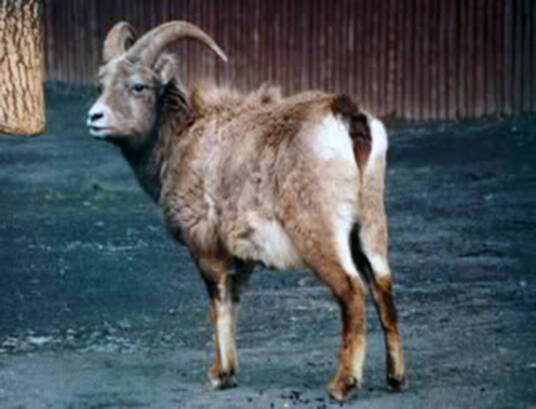Ovis nivicola
IUCN
LCBasic Information
Scientific classification
- name:Ovis nivicola
- Scientific Name:Ovis nivicola
- Outline:Ungulata
- Family:Artiodactyla Bovidae Argali
Vital signs
- length:140-160cm
- Weight:60-120kg
- lifetime:About 9 years
Feature
Gray-brown fur with a small patch of lighter fur on the rump
Distribution and Habitat
The snowy mountain argali is found in most of the mountainous regions of eastern Siberia (Russia). The main range begins east of the Lena River and extends to the Tenkany mountains on the Chukotsk Peninsula on the western edge of the Bering Strait. It also occurs in the volcanic mountains of the Kamchatka Peninsula, and the southern limit of the species seems to be in the Yablonov Mountains south of the Lena River.
In addition, a completely isolated group, O. n. borealis, is restricted to the Putorana Mountains in the southern part of the Tamyr Peninsula (about 66° to 70°N and 92° to 98°E), east of the Yenisei River. The nearest population in Yakutia is separated by about 1,000 km.
Inhabits rocky alpine meadows in northeastern Russia. Occurs in rocky mountainous areas, above 1,700 m above sea level on the Putoran Plato, and above 2,000 m in the rest of the country.
Appearance
The Snow Mountain Sheep is 140-160 cm long, 95-112 cm tall at the shoulder, and has a 10 cm tail length; it weighs 60-120 kg. The fur is gray-brown, with a small patch of lighter fur on the rump. The wooly winter coat is a light coffee color. The front of the legs is a dark chocolate color, while the back edge may have white markings. A black band runs across the nose, between the eyes and the muzzle, which contrasts sharply with the bright white muzzle. The ears are small and dark gray in color. Both sexes have horns, but they are much lighter than those of the Canadian Sheep of the same genus, with up to 35% less horn material. Males grow up to 89 cm, and the horns curl back and up around the ears, and when the horns begin to turn over for the second time, they will spiral outward in older males. Although the circumference of the base of the male horn can reach 38 cm, the horns of females are significantly thinner and shorter, curving back in a saber-like manner.
Details
Snow Mountain Sheep (scientific name: Ovis nivicola) English Snow Sheep, Russia Chubuk, Snezhnyi Baran, there are 4 subspecies.

Snow Mountain Sheep usually do not migrate, but will make seasonal short-distance movements. Large groups are often segregated by sex, with older males forming small groups that live separately until late autumn, while the rest of the animals form mixed groups, which generally consist of 15-20 animals throughout the winter, and the group regroups after the ewes give birth in June. They are well-adapted mountain creatures, extremely agile and flexible, able to move quickly on steep, uneven terrain.
In groups of adult males, dominance hierarchies are formed mainly based on the size of their horns. Even during the breeding season, these hierarchies remain relatively stable, with larger males receiving most mating rights. However, if two males have roughly the same horn size, dominance or subordination is determined in a fight. They face each other from a distance, run towards each other with their heads lowered, raise their heads and butt their horns together, trying to throw their opponent off balance and win.
The diet of the snow mountain argali consists mainly of grass, lichens, mosses and willow buds.
Mating occurs in November-December, pregnant females leave the flock in early spring, and lambs are born in late June. The average gestation period is 8.5 months. One lamb is born per litter, and the lamb weaning period takes 4-6 months. Females become sexually mature at 2 years old, while males do not become sexually mature until 5 years old. Lifespan is 9 years. Their maximum lifespan is reported to be much longer than other wild sheep.
In the mid-1980s, the population size of the snow mountain argali was estimated to be between 85,000 and 95,000; including 12,000-13,000 in Kamchatka, 55,000-60,000 in Yakutia, 10,000-12,000 in Okhotsk, 3,500 in Kory, 3,000 in Koryak, 3,000 in Chukotsk, 3,000-3,500 in Chukotsk, and 3,500 in Putorana. In 1999, the Putorana subspecies was reported to be increasing, but the population trends of the other subspecies were different. According to the Kamchatka Sport Fisheries and Wildlife Service (2007), in 2008 the nominate subspecies numbered about 7,000 individuals, of which 150 were hunted annually. The Putorana subspecies is a protected subspecies, and its population size has increased over the past decade, reaching 5,500 individuals as of 2008 (Ministry of Natural Resources of the Russian Federation, Natural World Heritage Committee). The population size in Chukotsk is estimated at 1,500 individuals. The species density varies from 0.3-3.5 individuals per 1,000 ha, and in some parts of its range (Rarytkin, Zolotoy and Elekay Mountains, northern and southern Vapanaivaam Mountains) only a single individual has been registered (Russian Federation Red List 2000).
Listed in the IUCN Red List of Threatened Species (IUCN) 2008 ver3.1 - Least Concern (LC).
Protect wild animals and stop eating game.
Maintaining ecological balance is everyone's responsibility!








